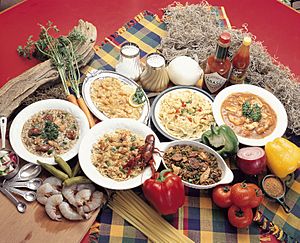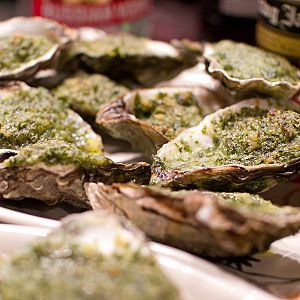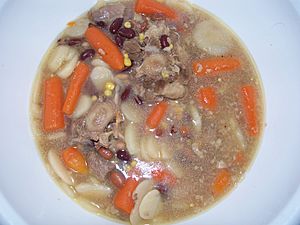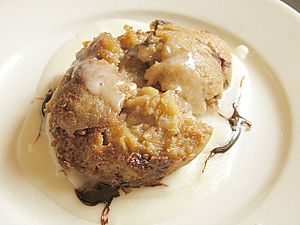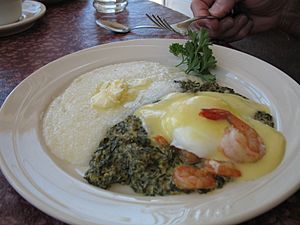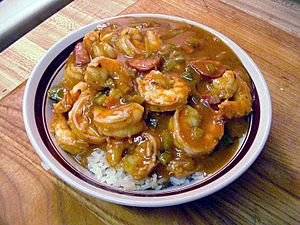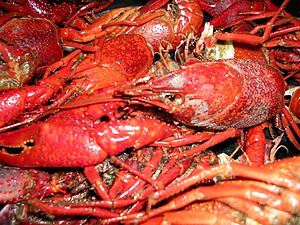Louisiana Creole cuisine facts for kids
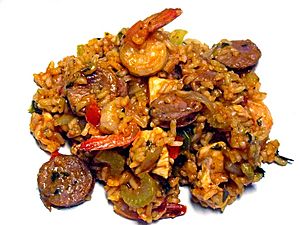
Louisiana Creole cuisine is a special way of cooking that comes from Louisiana, United States. It mixes flavors and ideas from West African, French, Spanish, and Native American foods. It also has influences from other Southern US cooking styles.
Creole food is shaped by the different groups of people who lived in Louisiana before it became part of the United States in 1803. The word "Creole" first described the families of French and Spanish leaders. Over time, it also included people born in Louisiana who were of African descent, and those with mixed backgrounds.
Just like the people, Creole food is a mix of many cultures from New Orleans. This includes West African, French, Spanish, Caribbean, and Native American influences. Creole cooking is often seen as a bit more fancy or "high-brow" compared to Cajun cuisine.
Contents
History of Creole Cooking
A very important cookbook for Creole food is "The Picayune Creole Cook Book." It was first printed in 1900. At that time, many people who used to cook Creole food were moving away from New Orleans. Local newspapers worried that the special cooking secrets would be lost forever.
The recipes in this cookbook were put together by someone who worked at the Daily Picayune newspaper. They said the recipes came from "the old Creole 'mammies'." Since then, the book has been printed 16 more times. The original recipes have changed very little.
Classic Creole Dishes to Try
Appetizers
- Oysters Bienville
- Oysters en brochette
- Oysters Rockefeller
- Shrimp remoulade
Soups
- Bisque (a creamy soup)
- Gumbo
- Turtle soup
Main Dishes
- Chicken Creole
- Creole Chicken Fricassee
- Creole Baked Chicken
- Crawfish étouffée (a seafood stew)
- Jambalaya
- Mirliton (a type of squash)
- Pompano en Papillote (fish cooked in paper)
- Red Beans and Rice
- Rice and gravy
- Shrimp bisque
- Shrimp creole
- Smothered Pork Chops
- Trout a la meunière (trout with butter sauce)
Side Dishes
- Red beans
- Dirty rice
- Smothered green beans with sausage and potatoes
Sweet Desserts
Sugar first came to Louisiana in the mid-1700s. People could chew sugarcane for sweetness. Later, in 1795, a person named Etienne de Bore figured out how to make sugar crystals. This happened at his farm, which is now Audubon Park in New Orleans.
Sugar became a very important crop, even more than cotton. By 1840, Louisiana had over 1,500 sugar mills. Many people were forced to work on these sugar farms. Louisiana made about 90% of all the sugar in the southern United States before the Civil War.
One old Southern dessert was Sally Lunn bread. It was made with butter and eggs, and felt like cake. During the Civil War, when some ingredients were hard to find, cooks used corn flour or rice flour instead of wheat flour. They also used honey instead of sugar.
Creole cooking is famous for desserts like king cake, pralines, and sweet dough pie. Desserts often use local fruits and nuts, such as berries, figs, and pecans. In the early 1900s, cane syrup became a popular ingredient. It's used in pecan pie, gingerbread, spice cookies, and Gâteau de Sirop (syrup cake). It's also served with pancakes or hot buttermilk biscuits, much like maple syrup in New England.
- Bananas Foster
- Beignets (fried dough)
- Doberge cake
- Banana pudding
- Bread pudding
Drinks
- Café Brûlot (flaming coffee)
- Café au lait (coffee with milk)
- Ramos Gin Fizz
- Sazerac cocktail
Breakfast Favorites
- Calas (fried rice fritters)
- Eggs Sardou
- Grits and Grillades (meat and gravy with corn grits)
- French toast (called Pain perdu, meaning "lost bread")
Condiments
- Creole cream cheese
- Pepper jelly
- Remoulade (a creamy sauce)
- Creole mustard
Creole Cooking Methods
- Barbecuing: Cooking slowly over low heat, similar to other Southern barbecue styles, but with Creole spices.
- Baking: Cooking with dry heat in an oven.
- Grilling: Cooking with direct heat on a hot surface. This includes:
- Charbroiling: On a grill with wide ridges.
- Gridironing: On a grill with narrow ridges.
- Griddling: On a flat surface, often with oil or butter.
- Braising: Starting on a grill, then finishing in a pot with broth.
- Boiling: Cooking in seasoned liquid, like for crabs or crawfish.
- Deep frying: Cooking food completely covered in hot oil.
- Smothering: Cooking vegetables or meat slowly with a little water or broth. Étouffée is a popular example with crawfish or shrimp.
- Pan-broiling or pan-frying.
- Injecting: Using a large needle to put seasoning deep inside big pieces of meat. This is a newer but common technique.
- Stewing: Also known as fricassée, cooking food slowly in liquid.
More recently, deep-frying turkeys or oven-roasting turduckens (a turkey stuffed with a duck stuffed with a chicken) have become popular in Louisiana.
Ingredients Used in Creole Cooking
Here are some common ingredients in Creole cuisine.
Grains
- Corn
- Rice: Long, medium, or short grain white rice. Rice is very important in Creole cooking. It grows well in Louisiana's warm, wet climate. It became the main starchy food because it was easy to grow, store, and cook. The oldest rice mill in the US, the Conrad Rice Mill, is in New Iberia.
- Wheat (for baking bread)
Fruits and Vegetables
- Bell peppers
- Blackberries
- Cayenne peppers
- Celery
- Collard greens
- Cucumbers
- Figs
- Limes
- Lemons
- Mirlitons (also called chayotes)
- Muscadines (a type of grape)
- Okra
- Onions
- Satsuma oranges
- Scallions (also called green onions)
- Squash
- Strawberries
- Sweet potatoes
- Tabasco pepper
- Tomatoes
Meat and Seafood
Creole traditions include many ways to keep meat fresh, though refrigeration is now common. Smoking meats is still popular.
Wild game is also very popular in Creole cooking.
More catfish are now farmed in the Mississippi Delta. This means more catfish is used in Creole cooking, sometimes instead of wild-caught trout or redfish.
Seafood
- Freshwater fish:
- Bass (often called green trout)
- Catfish
- Sac-au-Lait (white perch or crappie)
- Yellow perch
- Saltwater or brackish water fish:
- Shellfish:
Some less common fish that fishermen used to bring home for their families include garfish, black drum (gaspergou), croaker, and bream.
Poultry
Pork
- Andouille (a spicy, smoked sausage)
- Chaurice (like Spanish chorizo)
- Ham hocks
- Wild boar or feral hog
- Head cheese
- Pork sausage (fresh, highly seasoned)
- Salt pork
Beef and Dairy Beef is not as common in unique Creole dishes. It's usually cooked simply as chops, stews, or steaks. Ground beef is used like in other Southern US cooking, but with different seasonings.
Dairy farming is less common now, but some unique dairy items like Creole cream cheese are still made.
Other Game Meats
- Alligator
- Alligator gar
- Frog (often bullfrogs)
- Gros bec (Night heron)
- Nutria
- Squirrel
- Rabbit
- Skunk (mouffette)
- Turtle
- Snake
- Virginia opossum (sarigue)
Creole Seasonings
Individual Spices and Herbs
- Bay leaf
- Oregano
- Bell peppers (green or red)
- Black pepper
- Cayenne pepper
- Celery
- Garlic
- Onion (Bell pepper, onion, and celery together are called the "holy trinity" of Creole cooking.)
- Parsley, flat leaf
- Sassafras leaves (dried and ground into filé for gumbo)
- Dried shrimp
- Sugarcane, cane syrup, brown sugar and molasses
- Thyme
Blended Seasonings
- "Creole spice" mixes like Tony Chachere's are sometimes used. However, many Creole cooks prefer to mix their own spices from scratch.
- Whole peppers are almost never used in real Creole dishes. Ground cayenne, paprika, and hot sauces are more common.
- Hot sauce
- Seafood boil mix
- Vinegar with small, pickled, hot green peppers is a common side.
- Persillade (a mix of parsley and garlic)
- Marinades made with olive oil, brown sugar, and citrus juices.
- Various barbecue rubs.
Cooking Bases Knowing how to make a good roux is very important in Creole cooking. A roux is a mix of equal parts fat and flour. It's cooked until it turns a certain brown color. It's used to make sauces or soups thicker.
Creole roux in New Orleans are usually lighter than Cajun roux. They are often made with butter or bacon fat and flour. But some Creole dishes use a dark roux.
Dark roux are usually made with oil or bacon fat and flour. The smell of a good roux is so strong that it can stay on clothes! In Louisiana, people can often tell if someone is making a roux, and they guess they are making gumbo.
The secret to a good gumbo is matching the roux to the main ingredient, just like pairing wine with food.
- Light roux: This roux is light golden brown. It's best for seafood dishes because its mild flavor won't overpower the delicate seafood.
- Medium roux: This is the most common type in New Orleans Creole cooking. It turns the color of a copper penny or peanut butter. It works well with most Creole dishes and adds a warm, browned flavor to gumbo.
- Dark roux: This roux has a strong, nutty flavor. It would be too strong for a simple seafood gumbo. But it's perfect for gumbos with chicken, sausage, crawfish, or alligator. A dark roux is about the color of milk chocolate.
Making a dark roux is tricky. It means heating oil or fat and flour very carefully, stirring constantly for 15–45 minutes. It's easy to burn the flour, which would ruin the dish. A heavy pot helps stop it from burning.
- Stocks: Creole stocks can be more heavily seasoned than other stocks. Shellfish stock, made with shrimp and crawfish heads, is unique to Creole cooking.
- Fish stock and Court-bouillon (a flavored liquid)
- Shellfish stock
- Chicken stock
Popular Creole Dishes
Primary Favorites
Gumbo is a famous stew-like soup from Louisiana. It comes from West African okra soups, and the name "gumbo" comes from the French word for okra. Okra is often used to make gumbo thicker and gives it a special taste. Today, gumbo can be made with or without okra. If it doesn't have okra, it's often thickened with filé, a spice made from ground sassafras leaves. Chicken gumbos often use filé instead of okra.
Traditionally, seafood gumbo is more common in summer when okra is fresh. Chicken or wild game gumbo is more common in winter. But now, you can find all kinds of gumbo year-round in Louisiana.
A filé gumbo is thickened with dried sassafras leaves after cooking. This idea came from the Choctaw Native Americans. The main part of a gumbo is the roux, which can be medium or dark. It's made from flour toasted in fat or oil until it's well-browned.
Jambalaya is a dish that always has rice and some kind of meat (like chicken or beef) or seafood (like shrimp or crawfish). It can also have almost anything else! Usually, you'll find green peppers, onions, celery, tomatoes, and hot chili peppers. Everything else is optional.
Jambalaya started in Louisiana when Spaniards tried to make their favorite dish, paella, in the New World. Over time, it changed and took on Louisiana flavors. Jambalaya is a rice casserole with lots of seasoning.
Shrimp Creole is a favorite Creole dish in the New Orleans area. It's made with shrimp, tomatoes, onion, bell pepper, celery, garlic, and cayenne pepper. Classic shrimp creole doesn't usually have a roux, but some cooks might add one. It's an old Creole dish that shows its strong French and Spanish roots.
Red Beans and Rice is one of the most common dishes in New Orleans. It's cooked in homes and restaurants everywhere. Red beans came to New Orleans with French Creoles from Haiti. They moved to New Orleans during the slave uprising in Haiti. This wonderful stew of red beans has a strong Caribbean influence.
Rice and Gravy dishes are a main food in Creole cooking. They usually have a brown gravy made from meat drippings. This gravy is simmered with extra seasonings and served over steamed or boiled rice. This dish is traditionally made with cheaper cuts of meat. It's often cooked in a cast-iron pot for a long time to make the meat tender. Beef, pork, chicken, or many kinds of game meats can be used. Popular local versions include hamburger steak, smothered rabbit, turkey necks, and chicken fricassee.
Primary Desserts
Bread Pudding is a dessert made from day-old or stale French bread. It's a popular Creole and Cajun dessert. It also has eggs, milk, cinnamon, and vanilla.
Food as an Event
Crawfish Boil
A crawfish boil is a fun event where people boil crawfish, potatoes, onions, and corn in big pots over propane burners. The crawfish boil is a central event for both Creole and Cajun cooking.
Lemons and small bags of spices (like bay leaves, mustard seeds, and cayenne pepper) are added to the water for seasoning. These spice bags are often called "crab boil" or "crawfish boil." The cooked food is then dumped onto large tables covered with newspaper. Sometimes, more Creole spice blends are added.
People sometimes use cocktail sauce, mayonnaise, and hot sauce too. The seafood is put on big trays or plates and eaten by hand. When crawfish are not in season, shrimp and crabs are often cooked and served the same way.
See also
 In Spanish: Gastronomía criolla de Luisiana para niños
In Spanish: Gastronomía criolla de Luisiana para niños


